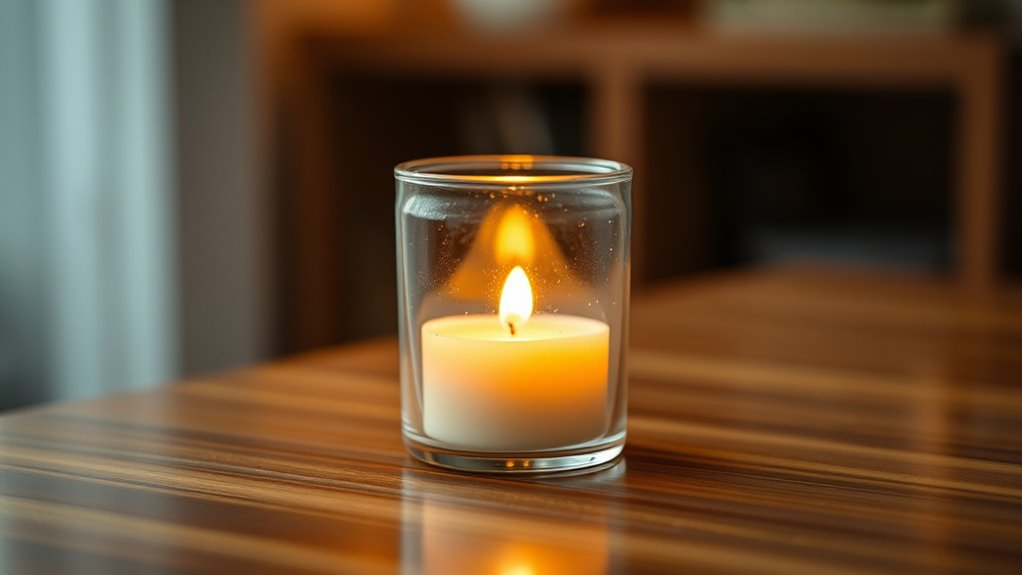Ambient humidity can sabotage your candle’s scent throw by affecting how fragrance molecules escape and disperse. When the air is humid, moisture on the wax and fragrance oils slows down scent diffusion, making it less potent and less able to fill your space. In dry conditions, the scent may evaporate too quickly or seem weak. Controlling humidity levels helps your candle perform better, and there’s more to discover if you keep exploring the topic.
Key Takeaways
- High humidity causes moisture buildup on wax and fragrance oils, hindering scent molecule release.
- Excess moisture alters wax melting points, reducing fragrance diffusion and room-filling capacity.
- Humid conditions trap fragrance oils within the wax, resulting in a muted scent throw.
- In dry environments, rapid evaporation of scent molecules leads to inconsistent fragrance dispersal.
- Proper candle placement and humidity control are essential to optimize scent dispersal and candle performance.

Ambient humidity levels can considerably influence how candle scents disperse and linger in your space. When the air is too humid or too dry, it directly affects the fragrance dispersal from your candles. High humidity increases the moisture impact on the wax and fragrance oils, leading to a less effective scent throw. In such conditions, the scent molecules struggle to escape the wax and diffuse into the room, making your candles seem less potent and less enjoyable. Conversely, when the air is dry, the lack of moisture can cause the fragrance to evaporate too quickly or not disperse evenly, resulting in an uneven scent experience. Both extremes hinder the candle’s ability to fill your space with the intended aroma.
Understanding how moisture impacts fragrance dispersal is key. In humid environments, excess moisture can cause the wax to absorb more water, which alters the melting point and prevents the wax from releasing fragrance oils efficiently. This results in a dull, muted scent that doesn’t fill the room as expected. The fragrance oils may also cling to the wax or become trapped, reducing their ability to diffuse into the air. On the other hand, in very dry conditions, the fragrance molecules tend to evaporate faster, often before they have a chance to disperse thoroughly. This rapid evaporation can make the scent fade quickly or seem weak, especially in larger spaces. In both cases, the moisture impact hampers your candle’s ability to deliver a consistent, strong fragrance.
Additionally, factors such as candle design and wax composition can influence how well your candle performs under varying humidity levels. Your environment plays a vital role in how well your candle’s scent performs. If you notice your candles aren’t filling the room like they used to, check the humidity levels. High humidity might require you to choose candles with stronger or more concentrated fragrances, or to run a dehumidifier to lower moisture content in the air. In dry conditions, using humidifiers can help balance the environment and improve fragrance dispersal. Proper placement of candles also matters; avoid areas with excessive moisture, like near open windows, humidifiers, or bathrooms. Managing ambient humidity ensures that the scent molecules can travel freely, filling your space with the aroma you love. When you control the moisture impact, you maximize your candle’s fragrance dispersal and enjoy a more consistent, delightful scent experience.
Frequently Asked Questions
Can Humidity Levels Be Adjusted Indoors to Improve Scent Throw?
You can definitely adjust indoor humidity levels to enhance scent diffusion from your candles. Using humidity control devices like humidifiers or dehumidifiers helps maintain ideal moisture, preventing scent loss caused by too much or too little humidity. Keeping humidity in a balanced range ensures your candle’s fragrance disperses smoothly, making your space smell inviting. Regularly monitor and adjust humidity levels for the best scent throw and overall ambiance.
Do Certain Candle Wax Types React Differently to Humidity?
Ironically, your candle’s wax composition and fragrance solubility can react quite differently to humidity. Some wax types, like soy, absorb moisture, dulling the scent throw, while others, like paraffin, resist humidity better. So, yes, certain waxes are more sensitive, which means humidity can either enhance or sabotage your candle’s aroma. Understanding these reactions helps you choose the right wax for perfect scent diffusion, no matter the weather.
How Can I Measure Ambient Humidity at Home Accurately?
To measure ambient humidity at home accurately, you can use a hygrometer. First, guarantee it’s properly calibrated by following the manufacturer’s instructions or performing a DIY humidity measurement with a salt test. Place the hygrometer in your desired area and check the reading regularly. Calibration helps maintain precision, giving you reliable data to adjust your environment and protect your candles from humidity-related scent issues.
Are There Specific Scents More Affected by Humidity Than Others?
Scent sensitivity varies widely, and certain scents suffer more from humidity’s havoc. Fragrance stability struggles with floral and citrus notes, which tend to fade or become fuzzy in humid environments. You’ll find that rich, resinous, or woody scents hold their harmony better, maintaining their magic. So, if you want your candles to shine, choose fragrances less susceptible to humidity’s harsh hold, and enjoy consistent, enchanting candlelight comfort.
What Household Appliances Influence Indoor Humidity Affecting Candles?
Your household appliances like humidifiers and dehumidifiers directly influence indoor humidity levels, impacting your candles’ scent throw. Proper humidifier placement ensures moisture stays evenly distributed, preventing scent dilution. Conversely, dehumidifier effects can lower humidity too much, dulling fragrance release. Be mindful of these appliances’ settings and positions to maintain ideal humidity, allowing your candles to emit their full, rich scents without interference from fluctuating indoor moisture levels.
Conclusion
Don’t let high humidity throw a wrench in your candle’s scent throw. When the air’s too damp, your candle can struggle to release its fragrance fully, leaving you disappointed. To keep your candles smelling their best, pay attention to the weather and store them in a cool, dry spot. Remember, a little prevention goes a long way—don’t let humidity be the fly in your ointment and spoil your cozy ambiance.










